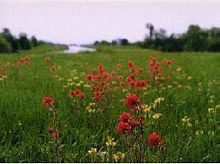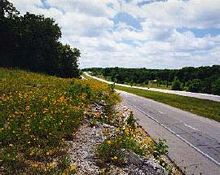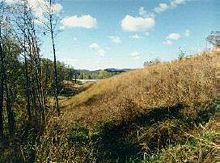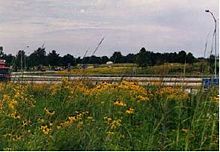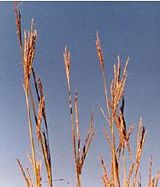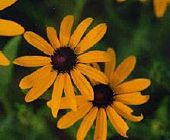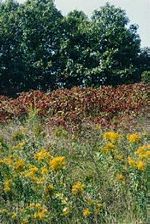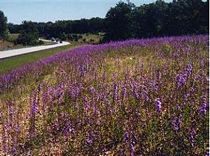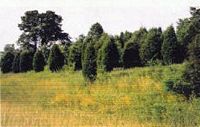822.5 Definitions
Biological Control: Usually involves the use of insects and disease-causing agents that attack certain weed species. An example is the control of musk thistle with the thistle head weevil. For effective biological control, the insect or disease must affect only the weed requiring control and the insects must have few natural enemies that interfere with their activity.
Brush: Coarse, woody vegetation growing in an undesirable location.
Chemical Control: The use of herbicides to control vegetation. Refer to EPG 821 Herbicides and Roadsides.
Consistency: Statewide seamless and continuous roadside management practices over time to ensure no abrupt changes are apparent at district or area boundaries.
Ditch Line: Ditch lines are considered to be to the back of a flat bottom ditch and to the bottom of a "V" ditch for roadside vegetation management purposes.
Divided Highway: Highway with physical separation of traffic in the opposite direction.
Endangered Species: Plants or animals considered by the state or federal government to be in danger of extinction or require protection to maintain their existence.
Hardscape Features: Landscape materials such as timbers, segmental block retaining walls and boulders that could create an obstacle if unprotected.
Herbicide Program: Utilize appropriate equipment, herbicides and trained personnel for the application of products as specified in EPG 821 Herbicides and Roadsides. The objective is to control noxious and undesirable plant species, as well as manage plant growth by applications of plant growth regulators and side trimming.
High-Profile Areas: Areas with high traffic counts which may be subjected to idle viewing by the motorist and/or have considerable pedestrian traffic.
Integrated Roadside Vegetation Management (IRVM): A decision-making and quality management process for maintaining roadside vegetation that integrates the following:
- needs of the local communities and highway users;
- knowledge of plant ecology, design, construction and maintenance considerations;
- monitoring and evaluation procedures;
- government statutes and regulations and
- technology.
IRVM uses cultural, biological, mechanical and chemical pest control methods to economically manage roadsides for safety plus environmental and visual quality.
Invasive Plant Species: An aggressive plant species which tends to spread. This includes noxious weeds.
Islands: Areas surrounded by driving lanes, turn lanes or ramps, etc. They may be vegetated or paved. They may be at-grade or raised.
Major Roads: The major highway system is all routes functionally classified as principal arterials. The principal arterial system provides for statewide or interstate movement of traffic. In urban areas, principal arterials carry traffic entering or leaving the urban area and serve for movement of vehicles between central business districts and suburban residential areas. The major roads in Missouri total approximately 5,500 centerline miles.
May: Permitted.
Median Width: Distance measured between the edge of traveled ways on a divided highway. The median width measurement includes the width of the inside shoulders.
Minor Roads: The minor highway system is all routes functionally classified as minor arterials or collectors. These routes mainly serve local transportation needs and include highways commonly referred to as lettered routes, such as Route A, Route C and Route DD. The minor roads in Missouri total approximately 28,400 centerline miles.
Mowing Cycle: The amount of time to mow and trim an area or route from start to finish is one cycle.
Native Grasses: Grasses which occur naturally or were known to exist prior to European settlement.
| Wildflowers and Native Grasses | |||
|---|---|---|---|
Natural Heritage Database Information: Geospatially referenced information about state and federally listed threatened and endangered species, species of conservation concern, and natural communities of conservation concern provided to MoDOT by the Missouri Department of Conservation. The information is used by authorized personnel within MoDOT to plan highway, bridge, and roadside construction and maintenance operations so impacts to rare species are avoided or minimized. For information and assistance, please contact the Environmental Section of the Central Office Design Division at (573) 526-4778.
Naturalized Areas: Areas allowed to flourish with native or non-invasive plant growth. These areas may have a random mix of what has established on its own or have selected vegetation management practices used to promote optimum desirable growth.
| Naturalized Areas | |||
|---|---|---|---|
Noxious Weeds: A plant which is troublesome and undesirable, and declared so by state law. Noxious weeds in Missouri are: Canada thistle, Scotch thistle, musk thistle, purple loosestrife, marijuana, Johnsongrass, multiflora rose, kudzu, cutleaf teasel, common teasel, field bindweed and spotted knapweed. MoDOT is thereby required by law to control these plants on right of way. The Johnsongrass law is subject to county option. Regardless of county option, the department shall make an effort to control this plant on right of way. Methods of control are specific to individual plants and EPG 821 Herbicides and Roadsides shall be followed in developing control practices. Control efforts should be documented.
Noxious Weed Control: Documented efforts to reduce and possibly eradicate an undesirable or noxious weed. Efforts include both chemical and biological methods.
Plant Growth Regulators (PGR): A chemical which suppresses the top growth and seedhead production of a plant. Should be mixed with a broadleaf herbicide to improve results.
Pollinators: Generally means any insect, bird or mammal capable of transferring pollen from flowers.
Raised Medians: Areas between driving lanes that may be grass or paved (or a combination) and are elevated.
Right of Way Line: MoDOT's property line between MoDOT and adjacent property owner.
Shall: Mandatory.
Should: Strongly recommended. Expected in typical situations with exceptions explainable.
Sight Distance: All vegetation should be maintained at intersections and curves along state rights of way to maximize drivers' visibility. Most sight distances can be maintained by a clear view unobstructed by vegetation, along the main roadway approximately 6 to 10 ft. from the edge of the traveled way. At intersections created by cross roads and gore points, the sight distance may need to be extended if necessary.
Slope Indicators: A mechanical device that operates on the same basis as a (bubble) level by indicating the degree of slope.
Total Vegetation Control (TVC): A chemical(s) to eliminate all vegetation to reduce trimming around signs, guardrails and other objects. Application should not extend more than 30 in. from the object to reduce the risk of erosion.
Traveled Way: Portion of the roadway intended for movement of motorized traffic. The white line strip on the edge of the road surface would typically designate this.
Trimming: Vegetation control to eliminate unsightly growth remaining after the mowing is complete. Includes line trimming, pulling and other manual means. Vegetation control under or around fixed objects within the mowed area. To manage vegetation in such a manner that keeps it consistent with the surrounding vegetation.
Undesirables: Vegetation which chokes out, shades out or competes with the intended vegetation at the given location. This includes any plant in the wrong place. Undesirables include but are not limited to poison hemlock, giant ragweed, phragmites and others. Noxious weeds are included in this category. Several are listed in EPG 821 Herbicides and Roadsides.
Undivided Highway: Highway with no physical separation of traffic in the opposite direction.
Urban Areas: Fully developed areas where the surrounding land is dominated by housing developments and commercial properties. There are no large gaps of areas without housing or commercial development.
Visible Litter: Litter in a size or quantity noticeable to roadway travelers.
V-Ditch: Ditch with little or no flat bottom.
Wildflowers: Reoccurring broadleaf flowering plant in a naturalized area.

